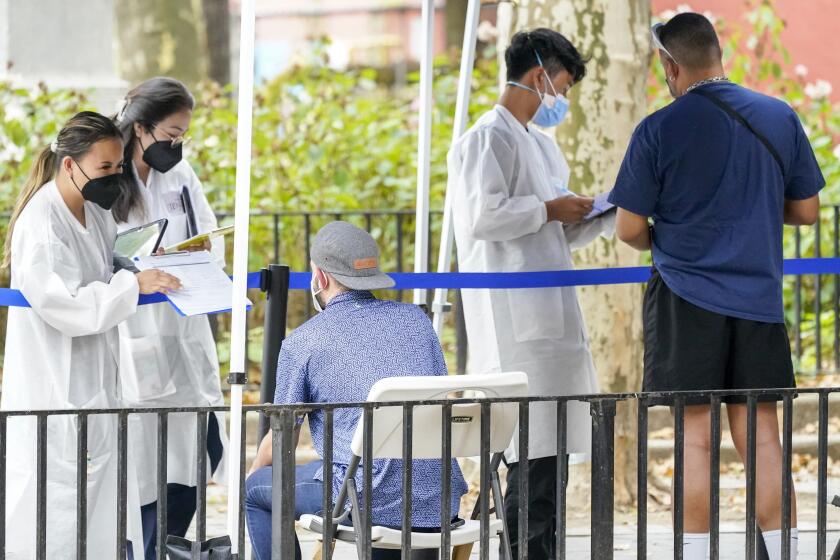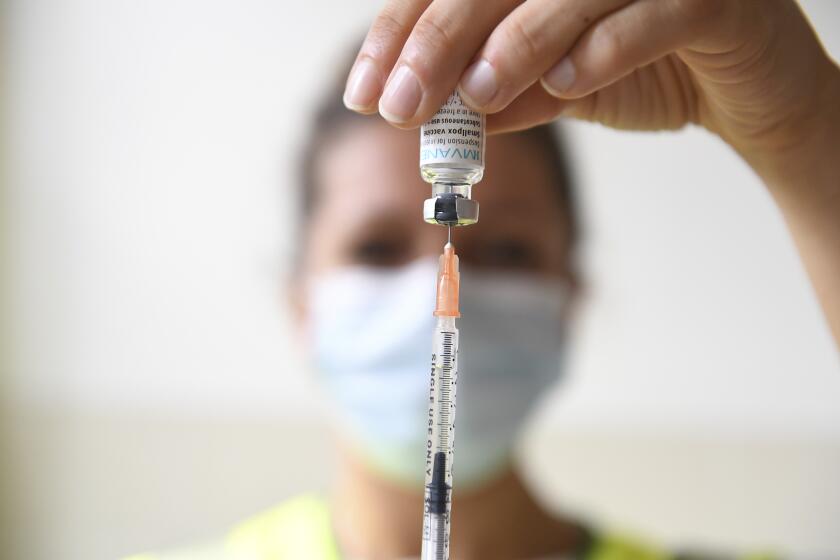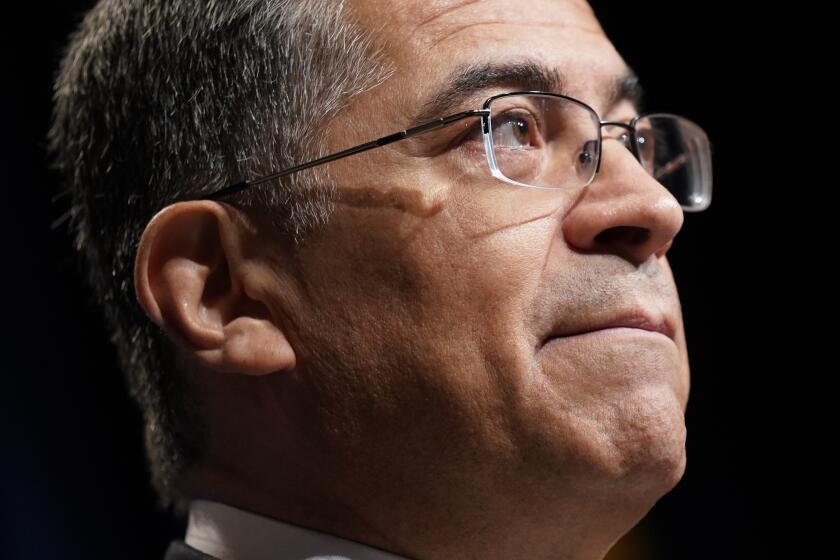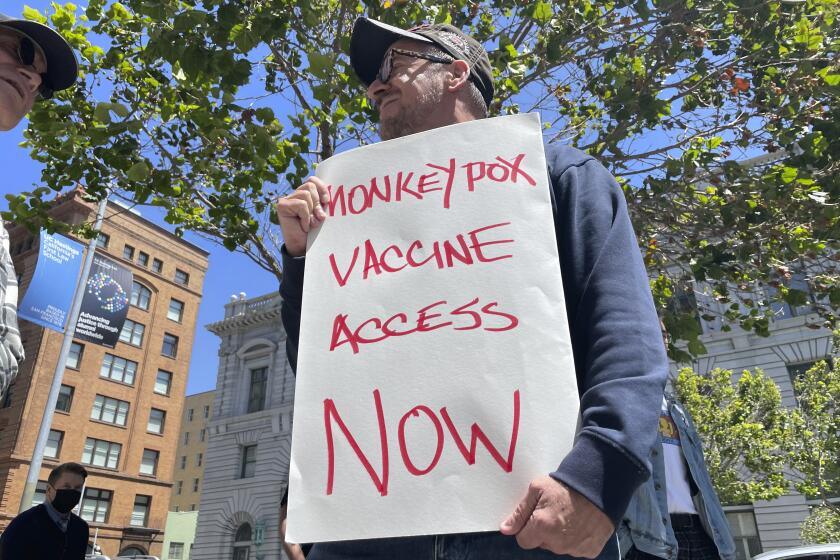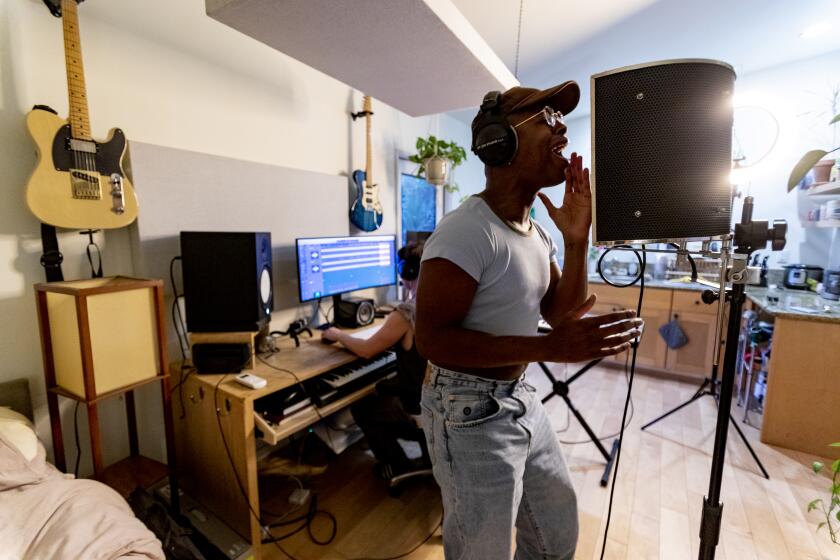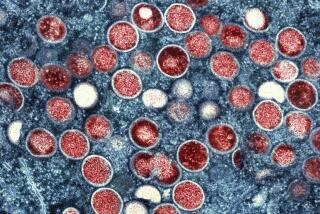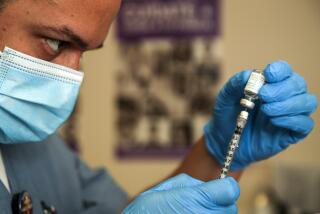As monkeypox cases spiral, U.S. will stretch supply of vaccine by giving smaller doses
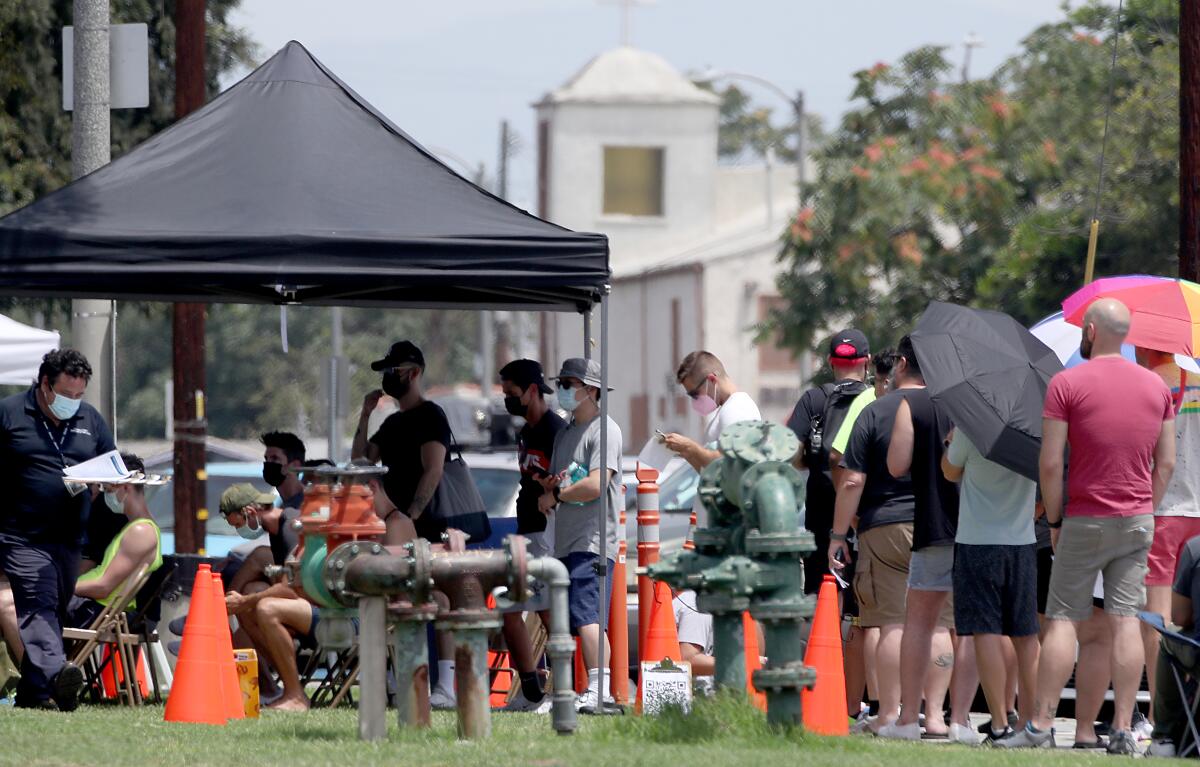
- Share via
As monkeypox cases continue to climb among high-risk people, federal officials on Tuesday announced that they will stretch limited vaccine supplies by giving just one-fifth the current dosage.
The move effectively quintuples the supply of monkeypox vaccine, a priority in hard-hit areas such as Los Angeles County and San Francisco, where the virus has been rapidly speading among men who have sex with men. Vaccine doses remain in short supply.
“In San Francisco, honestly, it’s a little bit like ‘The Hunger Games’ when it comes to accessing vaccination,” said state Sen. Scott Wiener (D-San Francisco). “It is heartbreaking.”
The new strategy is a “game-changer of increased supply of vaccine,” said Dr. Demetre Daskalakis, deputy coordinator of the White House national monkeypox response. Still, it is unlikely the approach will alleviate availability constraints, given robust demand among those considered to be at high risk.
“We will likely still run out of vaccines before we run out of arms,” Daskalakis said.
Who is eligible to get the monkeypox vaccination in Los Angeles right now? And how to do you get one? Here’s what to know.
The U.S. Food and Drug Administration on Tuesday issued an emergency-use authorization allowing healthcare providers to use a new vaccination technique for high-risk adults. Currently, the Jynneos vaccine is administered subcutaneously, under the skin and into the underlying fat. Moving forward, administrators will have the option to give the shots intradermally — shallower, between layers of skin — in a way that uses a smaller dose.
The Jynneos vaccine is a two-dose series, with shots administered four weeks apart. It can be used preventatively and within two weeks of an exposure.
“The monkeypox virus has continued to spread at a rate that has made it clear our current vaccine supply will not meet the current demand,” Food and Drug Administration Commissioner Dr. Robert Califf said. “The FDA quickly explored other scientifically appropriate options to facilitate access to the vaccine for all impacted individuals. By increasing the number of available doses, more individuals who want to be vaccinated against monkeypox will now have the opportunity to do so.”
This is not the first time vaccines have been rationed when doses are in short supply; the same strategy of administering doses intradermally has been used with polio and yellow fever, according to Dr. Peter Chin-Hong, an infectious diseases expert at UC San Francisco.
Additionally, Dr. Peter Marks, director of the FDA’s Center for Biologics Evaluation and Research, noted that the Jynneos vaccine has been administered intradermally in Germany, “so this isn’t the first time it’s been done.”
The new method can be tricky and will necessitate further training for clinicians. But if they administer the dose correctly, it will put the vaccine in a zone where there’s a high concentration of immune cells, “so you don’t need that much to stimulate the immune system,” Chin-Hong said.
The FDA’s action also allows people younger than 18 who are at high risk of infection to get the vaccine. But they will need a full dose administered subcutaneously, rather than the smaller intradermal dose.
Los Angeles County health officials said they’re awaiting instructions from federal officials and hope to implement the strategy once clinicians have been trained.
“With this new alternate regimen that we have just gotten notice about, we will now have five times the number of doses,” said Dr. Rita Singhal, chief medical officer for the L.A. County Department of Public Health.
Dr. Grant Colfax, director of health for the city and county of San Francisco, said the additional training means that the dosing change will not instantaneously boost supplies.
“I don’t think this is something that we could do overnight because of the training that will be required, but I do think it is a step in the right direction,” he said.
As monkeypox cases across California and the U.S. continue to rise, experts address some of the concerns and questions swirling about virus, and what activities people should consider risky, or not.
Roughly 9,500 monkeypox cases have been reported nationwide, according to the U.S. Centers for Disease Control and Prevention. More than 1,600 of those have been in California, according to a Times tally of data from L.A. and San Francisco counties and the state Department of Public Health.
“We have seen our first few pediatric cases and the first few female cases,” state epidemiologist Dr. Erica Pan said at a legislative hearing Tuesday.
Of the 885 California cases for which data are available, about 97% did not require hospitalization, state officials said. No deaths have been reported.
Most of California’s monkeypox infections have been documented in Los Angeles County and San Francisco. L.A. County has recorded 683 cases — a figure that has doubled in the last 10 days. San Francisco has been hit harder on a per capita basis, with 501 cases, despite having just 9% of L.A. County’s population.
Health experts say one of the only ways to get a handle on the outbreak is to dramatically increase vaccinations, adding that the more cases climb, the harder the spread will be to contain. Doctors fear that an increased spread could result in the virus becoming endemic in the wild animal population, meaning it would be virtually impossible to eliminate as a new disease of concern in the United States.
Gov. Gavin Newsom this month declared a state of emergency over the spread of the virus to “bolster the state’s vaccination efforts.” The White House has likewise declared the disease a public health emergency.
At a town hall last week in San Francisco, Chin-Hong expressed concerns about the rate at which monkeypox is spreading.
“When you look at the rates of increase, you can see that it’s really approaching an exponential curve. And unfortunately, it’s going to become harder and harder to control the ... higher these numbers get,” he said.
The move aims to fast-track potential new treatments and vaccines for the disease, which about 1.6 million Americans are at high risk of contracting.
According to the U.S. Department of Health and Human Services, about 618,000 vaccine doses have been shipped nationwide. More than 109,000 have been sent to California, including 43,000 to L.A. County.
That total is far short of the needed supply. There are 300,000 to 400,000 Californians at the highest risk for monkeypox, each needing two doses under traditional methods.
San Francisco has administered 12,000 doses but would need 150,000 to fully vaccinate the highest-risk residents, Colfax said.
“We have consistently run out of vaccine early in the week when we get our shipments,” he said.
There are an estimated 1.7 million U.S. residents considered at highest risk for monkeypox. Only 618,000 traditionally sized vaccine doses have been shipped nationally.
Wiener said the country’s response has been a public health failure, adding that the federal government must do more to expand vaccine supplies. When clinics have offered monkeypox vaccines, he said, supplies quickly run out.
“There’ll be a line three, four or five blocks long,” Wiener said. “People will show up at 2 or 3 in the morning, desperate to get a vaccine. … The San Francisco AIDS Foundation has a waitlist that is so massive that at some point people question, ‘Should I even put myself on that waitlist?’ It’s just not an acceptable way to do public health.”
Gov. Gavin Newsom declared a state of emergency in California over the spread of the monkeypox virus in order to “bolster the state’s vaccination efforts.”
The FDA based its dosing decision on data from a 2015 clinical study that found that individuals who received the vaccine intradermally had a similar immune response to those who got it subcutaneously.
“Administration by the intradermal route resulted in more redness, firmness, itchiness and swelling at the injection site but less pain, and these side effects were manageable,” the FDA said in a statement.
Chin-Hong said data as to the efficacy of the new dosing approach are limited, but public health officials had to act.
“As a public health practitioner, there’s no choice,” he said. “This is spiraling out of control, and the alternative ... was that we’d be seeing a lot of suffering in the next few months and a lot of disease. This is probably going to be as good an effort as any to really try to quell this continued outbreak on a steep curve.”
Smallpox was eradicated in 1980, so few people born after that year are vaccinated against it. Now the vaccine is being used to protect people from monkeypox. Here’s what to know.
Anyone can get monkeypox. However, it has spread rapidly in LGBTQ communities in part because contagious lesions can appear first in the rectum, urethra and mouth before appearing on the skin, and because the first symptoms can appear as innocuous as a pimple. That makes it possible for infected people who don’t know they’re contagious to pass on the virus during sexual encounters.
Cases are rising steeply among gay and bisexual men and transgender people who have sex with men, Chin-Hong said. About 98% to 99% of cases are among people in these groups.
The spread of monkeypox has been amplified by Pride events, specifically in saunas and at pool parties where there is intimate skin-to-skin contact, Chin-Hong said. The virus is not transmitted through pool water and generally not transmitted through surfaces in public. It can, however, be transmitted through infected bedsheets and other surfaces in the context of a household, where there is continued exposure over hours.
Gay and bisexual men, transgender people and others worried about monkeypox are strategizing to protect themselves as they wait for vaccinations.
Given the constrained supply of vaccine, California health officials have recommended that administrators prioritize first doses rather than stockpiling supplies for second doses — though immunocompromised individuals should receive a second dose within the 28-day interval whenever possible.
“While supplies remain scarce, vaccinators in California may offer first doses of Jynneos to additional persons at risk rather than retain inventory as second doses for immunocompetent persons, even if second doses are consequently administered at an interval greater than 28 days,” guidance from the California Department of Public Health states.
The Los Angeles County Department of Public Health “asks that all providers prioritize administering first doses of Jynneos vaccine to eligible immunocompetent persons to protect as many at-risk people as possible.”
Immunocompetent people are those without weakened immune systems, who can wait for a second dose, as opposed to those who are immunocompromised, who should get their second dose on time if possible.
Completing the series is vital, officials say. In a statement, the FDA said there’s no data indicating that one dose provides long-lasting protection, “which will be needed to control the current monkeypox outbreak.”
Vaccine protection is the highest two weeks after the second dose. The CDC is urging high-risk people to reduce their chances of infection through limiting their number of sex partners and refraining from sexual contact in saunas or at clubs, parties and other venues.
More to Read
Sign up for Essential California
The most important California stories and recommendations in your inbox every morning.
You may occasionally receive promotional content from the Los Angeles Times.
